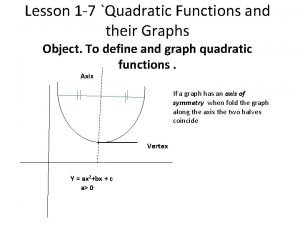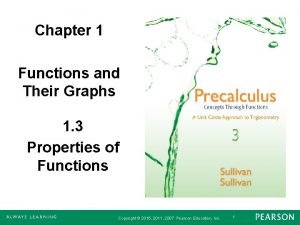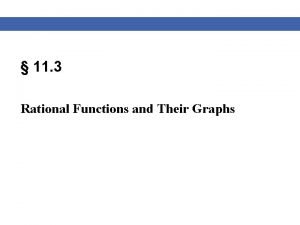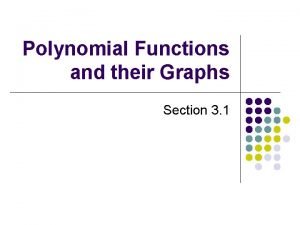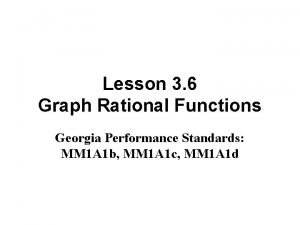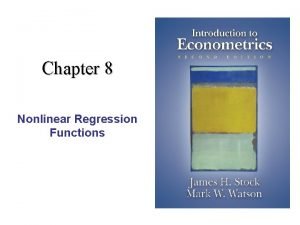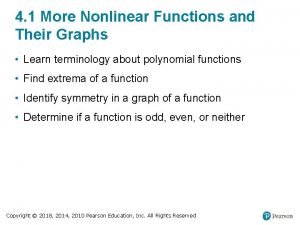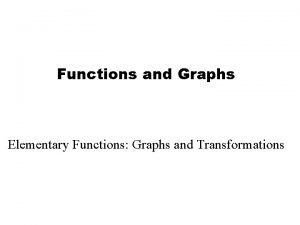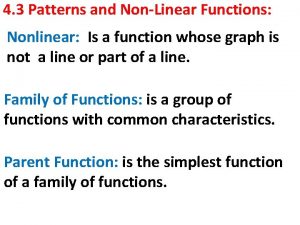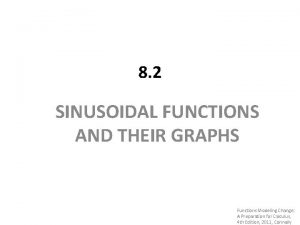4 1 Nonlinear Functions and Their Graphs Learn













- Slides: 13

4. 1 Nonlinear Functions and Their Graphs ♦ Learn terminology about polynomial functions ♦ Identify intervals where a function is increasing or decreasing ♦ Find extrema of a function ♦ Identify symmetry in a graph of a function ♦ Determine if a function is odd, even, or neither Copyright © 2006 Pearson Education, Inc. Publishing as Pearson Addison-Wesley

Polynomial Functions Polynomial functions are frequently used to approximate data. Copyright © 2006 Pearson Education, Inc. Publishing as Pearson Addison-Wesley Slide 4 - 2

Formulas, degrees, and leading coefficients of some polynomial functions include the following Formula Degree Leading Coefficient f(x) = 10 g(x) = h(x) = k(x) = Copyright © 2006 Pearson Education, Inc. Publishing as Pearson Addison-Wesley Slide 4 - 3

Increasing or Decreasing Functions The concept of increasing and decreasing relate to whether the graph of a function rises or falls. • Moving from left to right along a graph of an increasing function would be uphill. • Moving from left to right along a graph of a decreasing function would be downhill. We speak of a function f increasing or decreasing over an interval of its domain. Copyright © 2006 Pearson Education, Inc. Publishing as Pearson Addison-Wesley Slide 4 - 4

Increasing or Decreasing Functions continued Copyright © 2006 Pearson Education, Inc. Publishing as Pearson Addison-Wesley Slide 4 - 5

Example Use the graph of shown below and interval notation to identify where f is increasing or decreasing. Solution Copyright © 2006 Pearson Education, Inc. Publishing as Pearson Addison-Wesley Slide 4 - 6

Extrema of Nonlinear Functions Graphs of polynomial functions often have “hills” or “valleys”. Copyright © 2006 Pearson Education, Inc. Publishing as Pearson Addison-Wesley Slide 4 - 7

Extrema of Nonlinear Functions continued Maximum and minimum values that are either absolute or local are called extrema. Copyright © 2006 Pearson Education, Inc. Publishing as Pearson Addison-Wesley Slide 4 - 8

Absolute and Local Extrema Copyright © 2006 Pearson Education, Inc. Publishing as Pearson Addison-Wesley Slide 4 - 9

Group Work The monthly average ocean temperature in degrees Fahrenheit at Bermuda can be modeled by where x = 1 corresponds to January and x = 12 to December. The domain of f is D = {x|1 }. (Source: J. Williams, The Weather Almanac 1995. ) a) Graph f in [1, 12, 1] by [50, 90, 10]. b) Estimate the absolute extrema. Interpret the results. Solution Copyright © 2006 Pearson Education, Inc. Publishing as Pearson Addison-Wesley Slide 4 - 10

Symmetry If a graph was folded along the y-axis, and the right and left sides would match, the graph would be symmetric with respect to the y-axis. A function whose graph satisfies this characteristic is called an even function. Copyright © 2006 Pearson Education, Inc. Publishing as Pearson Addison-Wesley Slide 4 - 11

Symmetry continued Another type of of symmetry occurs in respect to the origin. If the graph could rotate, the original graph would reappear after half a turn. This represents an odd function. Copyright © 2006 Pearson Education, Inc. Publishing as Pearson Addison-Wesley Slide 4 - 12

Example Identify whether the function is even or odd. Solution Copyright © 2006 Pearson Education, Inc. Publishing as Pearson Addison-Wesley Slide 4 - 13
 5-3 polynomial functions
5-3 polynomial functions Horizontal asymptote rules
Horizontal asymptote rules Quadratic functions and their graphs
Quadratic functions and their graphs 8-3 practice rational functions and their graphs
8-3 practice rational functions and their graphs Chapter 1 functions and their graphs
Chapter 1 functions and their graphs Sketch the graph of the following rational function
Sketch the graph of the following rational function Common functions and their graphs
Common functions and their graphs Different types of polynomial
Different types of polynomial Polynomial functions and their graphs
Polynomial functions and their graphs Polynomial functions and their graphs
Polynomial functions and their graphs Exponential functions and their graphs
Exponential functions and their graphs Chapter 2 functions and their graphs answers
Chapter 2 functions and their graphs answers Rational functions and their graphs
Rational functions and their graphs Lesson 3: rational functions and their graphs
Lesson 3: rational functions and their graphs


